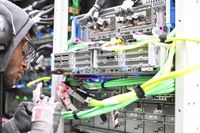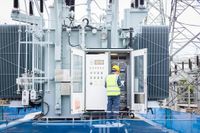Across America, the landscape is being transformed—not just by the familiar sprawl of cities or the hum of highways, but by a less visible force: the explosive growth of data centers. These facilities, driven by the insatiable appetite of artificial intelligence and cloud computing, now consume as much electricity as entire cities and are reshaping local economies, pushing the nation’s power grid to its breaking point.
According to a new report by JLL, data center vacancy rates in the United States have plummeted to a record low of 2.3% as of early 2025, a stark indicator of demand outpacing supply. Hyperscalers—those tech giants that run massive cloud platforms—are now requesting sites covering up to 1,000 acres and demanding multiple gigawatts of power. To put that into perspective, Andy Cvengros, executive managing director at JLL, told Quartz, “The amount of power being requested is like all of New York’s power in one single site.”
The numbers are staggering. In Chicago, utilities have received requests for 40 gigawatts of power—about 40 times the city’s current data center capacity. Yet, Cvengros estimates 90% of these requests are speculative, as developers flood the system hoping to flip permits for profit. The deluge of applications is overwhelming utilities, creating years-long backlogs even for legitimate projects.
The real demand, however, is highly concentrated. Half of all new data center growth in the first half of 2025 was centered in just two markets: Northern Virginia and Dallas. With so little space available, companies are now reserving capacity in data centers that haven’t even been built yet, sometimes waiting over a year for construction to finish before they can power up their servers. JLL projects that North America could see $1 trillion in data center development from 2025 to 2030, with more than 100 gigawatts of capacity potentially breaking ground. Already, 73% of the current eight-gigawatt construction pipeline is preleased, suggesting that tight vacancy will persist for years.
This rush isn’t happening in a vacuum. The International Energy Agency reported that global energy consumption jumped 2.2% in 2024—well above the decade-long average of 1.3%. In the U.S., the Department of Energy projects that data centers, which consumed 4.4% of the nation’s electricity in 2023, could devour up to 12% by 2028. The imbalance is causing headaches for utilities and regulators, especially as more traditional enterprise customers—banks, trading firms, healthcare companies—launch their own AI programs, further straining the grid.
Communities are feeling the effects, both good and bad. In Washington’s Grant County, 29 data centers have helped drive annual property taxes up 1,277% to $54 million over nearly two decades, according to GeekWire. The town of Quincy, which hosts most of the facilities, has used its newfound wealth to build a new school, hospital, fire station, and even plans for a deluxe soccer complex. Tax breaks passed in 2010 and expanded in 2022 have made the state a data center magnet, home to giants like Microsoft and Amazon. Property tax rates for local landowners have plummeted as a result.
But the windfall comes with tradeoffs. Electricity rates in Washington have soared 86% over the past 20 years, far outpacing the national average of 51%. Data centers now consume 5.7% of the state’s total electricity production, with more growth on the horizon as AI applications proliferate. Public utility districts are reporting requests from data center companies to double or even triple their current electrical loads. Water consumption is also a concern, as many data centers require vast cooling systems that can strain local resources.
Governor Bob Ferguson, recognizing the mounting challenges, created a workgroup earlier this year to study the economic and environmental impacts of data centers. The group faces a December 1 deadline to recommend policies that balance technology growth with sustainability. The urgency is heightened by President Trump’s AI Action Plan, which aims to slash regulations to speed up data center construction in support of artificial intelligence.
Other states are facing similar dilemmas. In Northern Virginia and Arizona, community opposition is mounting as the downsides of rapid data center expansion—strained grids, higher electricity costs, and environmental concerns—become more acute. As Emily Moore, director of climate and energy for the Sightline Institute, put it in a recent study, “Data centers are the first test of the Northwest’s climate ambitions. How leaders respond may chart the course for the rest of the economy’s clean energy transition.”
The situation is further complicated by the slow pace of infrastructure upgrades. Over 1,500 gigawatts of renewable energy projects worldwide are delayed because there aren’t enough transmission lines to deliver the power they generate, according to a Siemens report with Insider Studios. Even as distributed energy resources (DERs) like wind, solar, and hydro proliferate—California’s rooftop solar installations alone grew 34% year over year in 2023—grid operators are struggling to keep up. Investments in DERs are projected to increase sevenfold by 2030, reaching $846 billion globally, with another $285 billion earmarked for energy storage systems.
In response, companies are getting creative. JLL notes that 75% of new data center development is now concentrated in regions with low-cost electricity. Firms are also increasingly adopting alternative energy solutions, including on-site natural gas turbines and partnerships with fuel cell companies. But bottlenecks remain: critical equipment like transformers now have four-to-five-year lead times, further slowing progress.
Technology may offer a way out of the crunch. AI and machine learning are being deployed to dynamically manage grid stability and predict potential issues. At the Ercros chemical plant in Spain, for example, AI detected abnormal power consumption and prevented a costly outage by recommending timely maintenance. In Norway, Elvia—the country’s largest grid operator—uses AI-powered digital twins to manage low-voltage networks and prevent overloads. Siemens’ Gridscale X software is helping U.S. companies integrate AI for end-to-end grid visibility and control, enabling a shift from reactive to predictive energy management.
Meanwhile, major data center operators like Amazon and Microsoft are investing in next-generation clean energy technologies, including advanced nuclear reactors, geothermal, and fusion power. As a draft finding from Washington’s Data Center Workgroup notes, “The experience and expertise of these entities represent a potential resource for the state’s utilities as they expand and decarbonize the grid. Data centers may also have additional capital to invest in improving the grid.”
With the financial stakes sky-high—Morgan Stanley estimates the global industry will need $3 trillion in investment by 2028—questions remain about whether this massive spending can generate returns before the infrastructure becomes obsolete. OpenAI CEO Sam Altman recently acknowledged we’re in the midst of an AI bubble, but he still plans to spend “trillions” on data center construction.
For now, America’s power grid remains at a crossroads, squeezed by surging demand, slow infrastructure growth, and the relentless march of artificial intelligence. The next few years will test not only the resilience of the grid but the ingenuity of the companies, regulators, and communities determined to shape the future of energy and technology.





